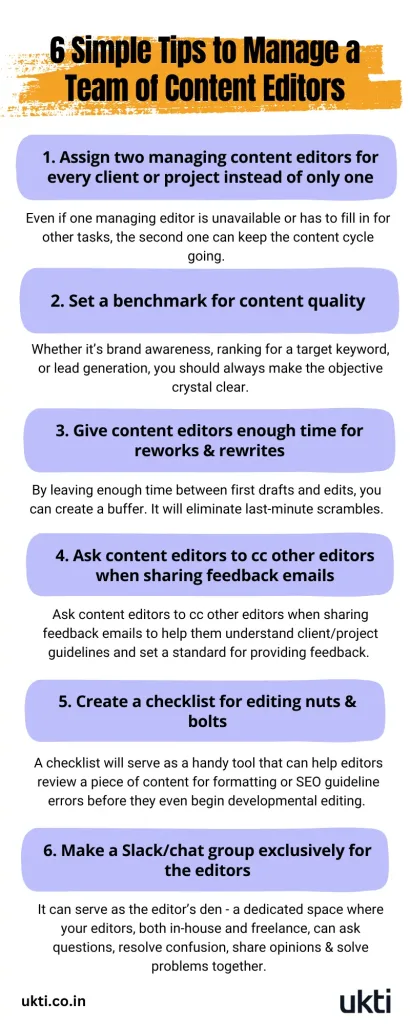A content writer, content editor, and content strategist walked into a bar. Who do you think cried first?
The editor, of course!
You know why? Because they didn’t make the cut….
(Sorry! Sorry!)
Putting my terrible pun aside, content editors do have the work cut out for them.
After all, who can help you hire a worthy writer, successfully train them, create content guides and processes, ensure timely delivery, and measure and report the metrics? Content editors are, in fact, tasked with a lot more than flagging poorly written sentences.
And now, with AI content creation tools gaining traction, they might even become prompt engineers on top of all this.
Now, when it comes to a small team of editors, you’re usually dealing with the following:
- Managing Editors (quality controllers and client whisperers)
- Assistant Editors (detail nerds and formatting experts)
Some of you may even have a mix of freelance proofreaders and copy editors to supervise. And this is where team management gets tricky.
At Ukti, we work with clients from diverse niches like B2B SaaS, BFSI, NFTs, education, fashion & lifestyle, and more. So, we have to produce not only authoritative content but also follow specific brand style guides as well. And in doing so, we’ve gathered some interesting insights.
Let me share them with you!
Here are 6 simple yet incredibly effective tips for managing a small team of editors.
- How Do You Manage a Team of Content Editors?
- 1. Assign two managing content editors for every client or project instead of only one
- 2. Set a benchmark for content quality
- 3. Give content editors enough time for reworks & rewrites
- 4. Ask content editors to cc other editors when sharing feedback emails
- 5. Create a checklist for editing nuts & bolts
- 6. Make a Slack/chat group exclusively for the editors
- To Conclude
How Do You Manage a Team of Content Editors?
1. Assign two managing content editors for every client or project instead of only one
Managing editors are not only responsible for meeting deadlines and overseeing content delivery. They’re the gatekeepers of content quality as well.
And sometimes, that can mean heavy developmental editing.
Now, between handling client communication, ensuring a smooth workflow, timely delivery, and training new writers, time is only lost and never found. Clearly, it’s not a one-person job.
That’s why having two managing editors for a particular client or project is better than having only one.
Even if one managing editor is unavailable or has to fill in for other tasks, the second one can keep the content cycle going. This saves your day and doesn’t disrupt your workflow.
Pro Tip: If two people have to serve the same role, there are typically more chances of a conflict. By clearly defining the role of both the editing managers and where they stand in the chain of command, you can avoid such pitfalls.
2. Set a benchmark for content quality
Content like works of art is highly subjective. However, we can all agree a good piece of content is one that meets the marketing objective.
Whether it’s brand awareness, ranking for a target keyword, or lead generation, you should always make the objective crystal clear. That’s how you can create better content as a team.
Then, show, don’t tell what type of content meets that objective. Usually, a piece of content loved by your sales team or customers can serve as the quality benchmark.
Now, take this piece of content and break it down for your content editors and writers. Write about its
- Structure
- Approach
- Framework
- Voice
- Context
- Narrative
Sweat the details, no matter how trivial. What should be the ideal length of a sentence? Two lines or three? Where to integrate the brand? In the introduction, middle, or end?
Wring out the copy and show what works and what doesn’t. Then, have the team memorise them like the lyrics to their favourite songs.
3. Give content editors enough time for reworks & rewrites
Diamonds might be made under pressure. But valuable content? It takes time.
If your content editors and writers are always working under a strict deadline, they can break under pressure. This can directly affect your content quality. And your ability to stay consistent.
To keep the content creation cycle going strong, make sure to leave enough time for reworks and rewrites. Otherwise, you’re only adding pressure on your editors’ shoulders.
By leaving enough time between first drafts and edits, you can create a buffer. It will eliminate last-minute scrambles and ensure you’re delivering only valuable content.
4. Ask content editors to cc other editors when sharing feedback emails
Employee churns affect smaller teams more than they do bigger ones.
That means whenever a new editor joins the team, you will need to bring them on the same page as the rest of your team. And in the least amount of time possible. How do you do it?
To begin with, you can share the processes, the chain of command, the content style guide and more. But this is all theoretical. Your editor will still likely feel like an outsider.
To show them how it’s done in practice, here’s the best approach.
When emailing feedback to the writers, keep the new editor(s) in cc from day 1. This will help them:
- See the client/project guidelines in action
- Understand the expected quality of content
- Set a standard for providing feedback
This is also a great way to induct freelance writers and bring them up to speed without a minute wasted.
5. Create a checklist for editing nuts & bolts
- Are the subheads in the proper case?
- Have the writers cited the sources correctly?
- Is there a brand integration in conclusion?
- Does the social copy meet the character limit?
- Are keywords used in the right density?
As I mentioned above, you need to sweat the details to ensure consistently good performance. So, make a last-minute checklist of details editors are most likely to overlook.
This will serve as a handy tool that can help editors review a piece of content for formatting or SEO guideline errors before they even begin developmental editing.
6. Make a Slack/chat group exclusively for the editors
While content editors do serve as gatekeepers of quality, they don’t always have the right answers to difficult questions. That’s why having a space where they can freely express doubts and challenges is so important.
A chat/Slack group is one such space. It can serve as the editor’s den – a dedicated space where your editors, both in-house and freelance, can ask questions, resolve confusion, share opinions, brainstorm, and solve problems together.
Or, they can simply vent their frustrations.
To Conclude
To recap quickly, here are the six tips you can use to manage your editorial team and keep content publishing on track.

The bottom line is to make the editor’s job easier. Provide appropriate tools, technology, or just plain old recognition. But create a conducive work environment where they can easily collaborate and always have help at hand.
Don’t want the hassle of managing a team of content editors and writers? Then, don’t do it. Outsource your content creation to Ukti to worry less and focus more on your next business goal!
About the Author:


5 thoughts on “6 Simple Tips to Manage a Team of Content Editors”